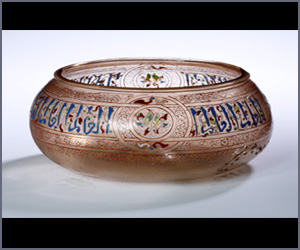|
Glass Industry
The
glass industry
thrived in Egypt
and Syria
. In both countries,
lamp shades were made in glass adorned with medallions,
inscriptions, or floral designs.
Syrian glasses had a far reaching reputation feeding the tastes
and the homes of wealthy Western households with glass products
of a diversity of shapes and usages.[1]
Aleppo and Damascus
were important centres
according to many witness; and so was Hama.[2]
Going through the inventories of the time, Heyd notes, can be
found bottles, goblets plates of glass, painted or decorated `on
the Damascus manner.’[3]
Egypt continued to produce vessels of all qualities,
particularly at Al-Fustat, where excavations yielded immense
quantities of glass ranging in date from the 8th
century to the later Middle Ages.[4]
In Spain, it was Ibn Firnas, who in the 9th century,
introduced the art of glass manufacturing and who taught the
artisans the technique of putting the clay in the oven.[5]
The transfer to the Christian West
of this industry took
place mainly during the crusader period.
The
Venetians acquired large manners of skills from the Syrians and
Egyptians with whom they were in close contact during the
crusades.[6]
The Christians pilfered Syrian coloured glasses believing
they were cut from precious stones, whilst Venice
imported from Tyre all
the pieces of broken glass, and misshapen bits so as to melt
them down in the early stages of the glass industry in that
city.[7]
Heyd highlights the role of the Jews
of Tyre, who have from
one generation to the other exerted amongst the Venetian colony
of that city their trades in glass making, and through them much
influence was exerted.[8]Glass
making was introduced
from Islamic Syria
to Venice following a
treaty between a local ruler and the Doge of Venice in 1277.[9]
Venetian craftsmen also used Eastern enamelling techniques, and
they also copied forms of decoration, especially the ever
popular application of rows of pearls and of scale patterns.[10]
Formulas of eastern inspiration designed to strengthen or to
colour glass also circulated in Christian Spain; several such
formule found in the Lapidario of Alfonso X
.[11]It
would not be surprising to find many such aspects circulating in
the northern Italian city of Florence in the 14th
century on the same pattern as other ideas and innovations taken
from the same court of Alfonso by the Florentine ambassador
Brunetto Latini back to Florence.
Djebbar notes how Islamic glass industry led to advances in
glasses (for vision) and optical sciences (telescopes).[12]There
is more on such links to be found in Selin’s edited
encyclopaedia under various entries.[13]
One
of the raw materials used to make glass was known in Syria
as `Al-Qali'. This was
potash, and the fact that the world passed into European
languages as `alkali' is symptomatic of the transfer of a
considerable body of chemical knowledge from the Islamic world,[14]
through books as well as in connection with processes of glass
making.[15]
[1]
Instances in Labarte: Inventaire du mobilier de Charles
V; p. 240 and sub in W. Heyd: Histoire; op cit; vol 2 ;
p. 710.
[2]
D. Whitehouse: Glass
in Dictionary
of the Middle Ages; op cit; vol 5; pp. 545-8.
[3]
Labarte; in W. Heyd: Histoire; op cit; vol2 ; p. 710.
[4]
D. Whitehouse: Glass
; op cit; pp. 546-7.
[5]
E. Levi Provencal: L’Espagne Musulmane; op cit; p. 184.
[6]
M. Ilg in W. Heyd: Histoire; op cit;
p. 710.
[7]
M. Lombard
: The Golden Age of Islam; tr by J. Spencer;
North Holland Publishers; 1975. pp.188-9.
[8]
W. Heyd: Histoire; op cit; p. 710.
[9]
A. Pacey:
Technology
, op cit, p.50.
[10]
R. Ettinghausen: Muslim Decorative Arts; op cit; p. 19.
[11]
Alfonso X
: Lapidario, Maria Brey Marņio, ed. Madrid;
Castalia, 1968, pp. 204-205 (chaps. 259, 269).
[12]
A. Djebbar: Une Histoire; op cit; pp 347-9.
[13]
H. Selin Editor: Encyclopaedia; op cit.
[14]
Al-Hassan and Hill
: Islamic
Technology, 1986, p. 153.
[15]
A. Pacey:
Technology
, op cit, p.50. |
